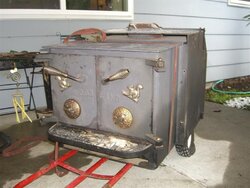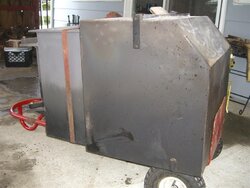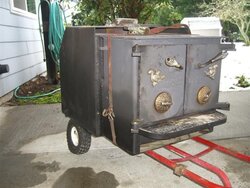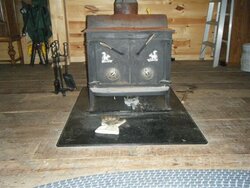Hey guys, first post here but I love the site. I've been lurking for years and I've always been able to find the answers I've been looking for without posting, but not this time...
I have what I believe to be a Fisher style insert that was in my house when I bought it last summer, but it says "Woodland" on it. Long story short, it was a typical slammer install into a brick fireplace with a 9"x13" terracotta lined brick chimney. We've been using it all winter and it is an awesome stove and heats our 1600 sq. ft. home with ease. Until we had a chimney fire last week.... The top few terracotta tiles now have cracks in them so I'm going to put a stainless steel liner in. After a ton of research, I now know that I should put a liner in no matter the condition of the brick chimney for draft and easier cleaning, among other reasons.
I have a few questions though... the stove has an 8" outlet but I'm wondering if 6" will be ok for cost reasons and to make it easier when/if I upgrade to a newer stove? Also, I'm wondering how necessary the flue damper is for my application. I have an idea how to hook the liner up to the stove and still keep the flue damper, but it would be a lot easier to just remove it. One last question, how necessary is it to insulate the the stainless liner? If I use the 6" liner, insulating will be easy, but a little more difficult if I need to use the 8".
A few details... single story 1600 sq. ft home. The chimney/fireplace is in the center of the house with about 3' above the peak of the roof, making it about 12' from the stove outlet to the rain cap. We live in western WA in a pretty temperate climate, mostly 30's and 40's this time of year sometimes dipping down to the 20's. We burn 24/7 mostly fir and alder, but sometimes maple and oak too.
Thanks a lot and I appreciate any help you can give.
A few pictures....
I have what I believe to be a Fisher style insert that was in my house when I bought it last summer, but it says "Woodland" on it. Long story short, it was a typical slammer install into a brick fireplace with a 9"x13" terracotta lined brick chimney. We've been using it all winter and it is an awesome stove and heats our 1600 sq. ft. home with ease. Until we had a chimney fire last week.... The top few terracotta tiles now have cracks in them so I'm going to put a stainless steel liner in. After a ton of research, I now know that I should put a liner in no matter the condition of the brick chimney for draft and easier cleaning, among other reasons.
I have a few questions though... the stove has an 8" outlet but I'm wondering if 6" will be ok for cost reasons and to make it easier when/if I upgrade to a newer stove? Also, I'm wondering how necessary the flue damper is for my application. I have an idea how to hook the liner up to the stove and still keep the flue damper, but it would be a lot easier to just remove it. One last question, how necessary is it to insulate the the stainless liner? If I use the 6" liner, insulating will be easy, but a little more difficult if I need to use the 8".
A few details... single story 1600 sq. ft home. The chimney/fireplace is in the center of the house with about 3' above the peak of the roof, making it about 12' from the stove outlet to the rain cap. We live in western WA in a pretty temperate climate, mostly 30's and 40's this time of year sometimes dipping down to the 20's. We burn 24/7 mostly fir and alder, but sometimes maple and oak too.
Thanks a lot and I appreciate any help you can give.
A few pictures....






